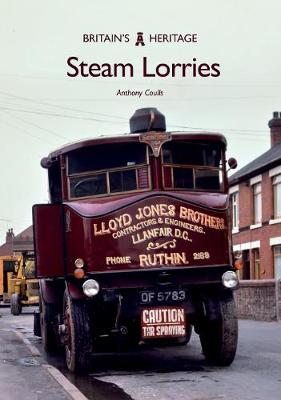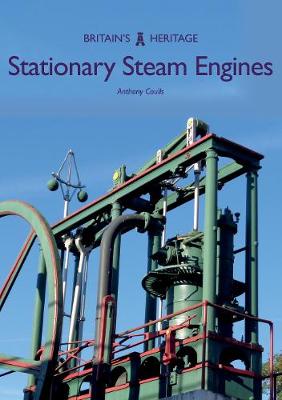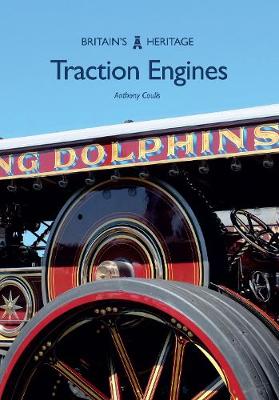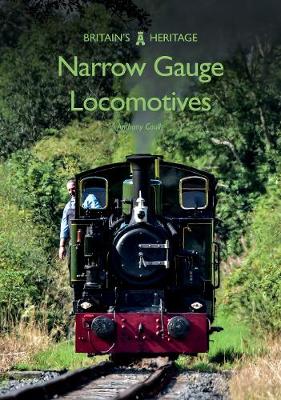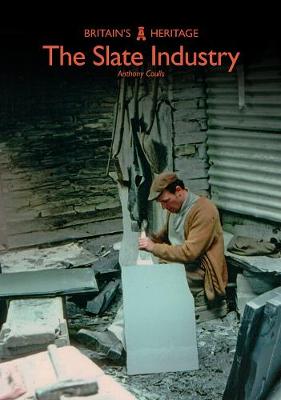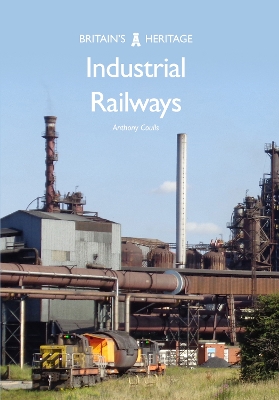Britain's Heritage
7 total works
Steam power led the transport revolution in England throughout the nineteenth century, but was crippled on the road network by punitive legislation. As the century turned, the laws were altered in such a way that the development of the English Steam Lorry or Wagon became a viable transport proposition.
For the best part of four decades, the steam lorry was a major player on the transport scene, being developed into a highly technical machine designed to beat competition from the petrol and diesel lorry. The most advanced machines were efficient and very fast. Made by a variety of builders, including the famous Sentinel company of Shrewsbury, who built waggons with a double ‘g’, and Foden, of Sandbach, steam lorries came in many shapes and sizes. This book looks at their birth, and the operation and engineering that set them aside from the traction engine and steam roller.
This book is part of the Britain’s Heritage series, which provides definitive introductions to the riches of Britain’s past, and is the perfect way to get acquainted with steam lorries in all their variety.
For the best part of four decades, the steam lorry was a major player on the transport scene, being developed into a highly technical machine designed to beat competition from the petrol and diesel lorry. The most advanced machines were efficient and very fast. Made by a variety of builders, including the famous Sentinel company of Shrewsbury, who built waggons with a double ‘g’, and Foden, of Sandbach, steam lorries came in many shapes and sizes. This book looks at their birth, and the operation and engineering that set them aside from the traction engine and steam roller.
This book is part of the Britain’s Heritage series, which provides definitive introductions to the riches of Britain’s past, and is the perfect way to get acquainted with steam lorries in all their variety.
Stationary steam engines were the quiet powerhouses of the Industrial Revolution. They provided the driving force behind every manufacturing process for well over a century, as well as drainage of mines and allowing clean water supplies for the majority of our towns and cities. From a small sewage pump at the edge of a field of a few horsepower, to a 12,000 horsepower leviathan rolling armoured plate for battleships, these wonders of the steam age kept working for many decades, unseen by many, but often loved by the men who operated and maintained them. The engine houses they were kept in could be plain or ornate, and a rich variety of boilers provided the steam for them.
This book looks at all of these aspects and what it was like to run a large steam engine for industry. The legacy of these iron giants is seen in the dozens of engines preserved for posterity all over the UK, in museums or in their original locations, giving thousands of people the chance to see them or enjoy getting involved in their preservation.
This book is part of the Britain's Heritage series, which provides definitive introductions to the riches of Britain's past, and is the perfect way to get acquainted with stationary steam engines in all their variety.
This book looks at all of these aspects and what it was like to run a large steam engine for industry. The legacy of these iron giants is seen in the dozens of engines preserved for posterity all over the UK, in museums or in their original locations, giving thousands of people the chance to see them or enjoy getting involved in their preservation.
This book is part of the Britain's Heritage series, which provides definitive introductions to the riches of Britain's past, and is the perfect way to get acquainted with stationary steam engines in all their variety.
In the nineteenth century, it became obvious that the UK's road system needed to be improved. Smoother roads were required to allow people to travel faster and more safely, and the engineers went to work to make this possible. In this book, author Anthony Coulls looks at one of the best known ways of doing this: the road roller.
The first road rollers were horse-drawn and these were followed in 1865 by the steam-powered road roller, which was seen on British roads for more than a century. Aveling & Porter of Rochester was the firm that dominated the steam roller market, although several other manufacturers made plenty. As technology improved, rollers began to get lighter and new forms of propulsion came in - petrol and diesel engines. Even though a road roller today will be one of these more modern types, the term 'steam roller' is a firm part of the public's imagination. The appeal of the steam roller means that hundreds survive to this day in the hands of enthusiasts, who take them to steam rallies up and down the country, and petrol and diesel rollers have great appeal too.
This book is part of the Britain's Heritage series, which provides definitive introductions to the riches of Britain's past, and is the perfect way to get acquainted with road rollers in all their variety.
The first road rollers were horse-drawn and these were followed in 1865 by the steam-powered road roller, which was seen on British roads for more than a century. Aveling & Porter of Rochester was the firm that dominated the steam roller market, although several other manufacturers made plenty. As technology improved, rollers began to get lighter and new forms of propulsion came in - petrol and diesel engines. Even though a road roller today will be one of these more modern types, the term 'steam roller' is a firm part of the public's imagination. The appeal of the steam roller means that hundreds survive to this day in the hands of enthusiasts, who take them to steam rallies up and down the country, and petrol and diesel rollers have great appeal too.
This book is part of the Britain's Heritage series, which provides definitive introductions to the riches of Britain's past, and is the perfect way to get acquainted with road rollers in all their variety.
The first traction engines were built around the middle of the nineteenth century. Their great pulling power and ability to provide power for other equipment revolutionised road haulage and agriculture.
Great makers like Burrell and Garrett from East Anglia, Taskers and Wallis & Steevens from Hampshire, Marshalls and Foster from Lincolnshire, and Fowlers and McLaren from Leeds filled Britain (and much of the rest of the world) with their engines. They ranged in size from the small road locomotives like Taskers' Little Giant, up to giant Fowler ploughing engines and the grandest Burrell showman's engine, resplendent in gold-lined paintwork and twisted brass canopy supports. The age of the traction engine was relatively short, declining rapidly after the First World War, but they have left an indelible mark, with enthusiasts up and down the country having saved hundreds of machines from the scrapmen to entertain us every weekend at steam fairs and other vintage events.
This book is part of the Britain's Heritage series, which provides definitive introductions to the riches of Britain's past, and is the perfect way to get acquainted with traction engines in all their variety.
Great makers like Burrell and Garrett from East Anglia, Taskers and Wallis & Steevens from Hampshire, Marshalls and Foster from Lincolnshire, and Fowlers and McLaren from Leeds filled Britain (and much of the rest of the world) with their engines. They ranged in size from the small road locomotives like Taskers' Little Giant, up to giant Fowler ploughing engines and the grandest Burrell showman's engine, resplendent in gold-lined paintwork and twisted brass canopy supports. The age of the traction engine was relatively short, declining rapidly after the First World War, but they have left an indelible mark, with enthusiasts up and down the country having saved hundreds of machines from the scrapmen to entertain us every weekend at steam fairs and other vintage events.
This book is part of the Britain's Heritage series, which provides definitive introductions to the riches of Britain's past, and is the perfect way to get acquainted with traction engines in all their variety.
Narrow gauge railways have long been a source of fascination for many. From famous public lines such as the Ffestiniog Railway and Lynton & Barnstaple Railway, to peat extraction lines in Cumbria and brickworks systems on Humberside, the narrow gauge railway has transcended two centuries.
A big part of the charm of these lines is the locomotives that were built to operate them. Narrow gauge is defined as anything less than the standard gauge of UK main lines - usually down to 15 inch gauge - but in that spectrum there is no limit to size, simplicity or shape. These were machines built to do a job, pure and simple, but those jobs were many and varied. Multiple wheeled complex engines could share the same track as a simple motorised wagon, whilst all manner of propulsion could be found - steam, diesel, petrol and electric - even fireless, compressed air or steam locos converted to electric power. This book looks at them all and their legacy today across the plethora of pleasure and heritage lines that exist.
This book is part of the Britain's Heritage series, which provides definitive introductions to the riches of Britain's past, and is the perfect way to get acquainted with narrow gauge locomotives in all their variety.
A big part of the charm of these lines is the locomotives that were built to operate them. Narrow gauge is defined as anything less than the standard gauge of UK main lines - usually down to 15 inch gauge - but in that spectrum there is no limit to size, simplicity or shape. These were machines built to do a job, pure and simple, but those jobs were many and varied. Multiple wheeled complex engines could share the same track as a simple motorised wagon, whilst all manner of propulsion could be found - steam, diesel, petrol and electric - even fireless, compressed air or steam locos converted to electric power. This book looks at them all and their legacy today across the plethora of pleasure and heritage lines that exist.
This book is part of the Britain's Heritage series, which provides definitive introductions to the riches of Britain's past, and is the perfect way to get acquainted with narrow gauge locomotives in all their variety.
Slate from British quarries roofed the world. For a period in the nineteenth century, ships exported thousands of tons of roofing slate from the UK to an international market. The development of slate as a roofing material drove the business of extraction, but many other slate products have been made as well, including writing slates, electrical installations and even snooker tables.
Slate is synonymous with North Wales, where a bid for World Heritage Site status is being made for the landscape formed by quarrying, but there was also a slate industry in Leicestershire, Cornwall and Cumbria. The enormous physical remains of the quarries themselves have sometimes developed as tourist attractions and at other times have been left as landscape features ripe for exploration and discovery.
This book is part of the Britain's Heritage series, which provides definitive introductions to the riches of Britain's past, and is the perfect way to get acquainted with the slate industry in all its variety.
Slate is synonymous with North Wales, where a bid for World Heritage Site status is being made for the landscape formed by quarrying, but there was also a slate industry in Leicestershire, Cornwall and Cumbria. The enormous physical remains of the quarries themselves have sometimes developed as tourist attractions and at other times have been left as landscape features ripe for exploration and discovery.
This book is part of the Britain's Heritage series, which provides definitive introductions to the riches of Britain's past, and is the perfect way to get acquainted with the slate industry in all its variety.
Since the dawn of the railways, away from the glamour of the main line express, thousands of miles of industrial railway moved raw materials and finished products. From sewage works to sugar factories, all manner of industries were served. These sometimes employed dozens of locomotives, or in other cases simply a horse or a petrol tractor.
The Beckton gas works in London ran a massive railway, complete with locomotive roundhouse and signals, while the ironstone industry of the East Midlands operated on the edge of fields. It can be said that one was never more than a mile or two from an industrial railway, though often its existence might not have been well known. A corncucopia of locomotives provided power, while a fantastic array of specialist wagons moved all manner of goods. A few industrial lines have survived as heritage attractions, and one is even a Scheduled Ancient Monument.
This book is part of the Britain’s Heritage series, which provides definitive introductions to the riches of Britain’s past, and is the perfect way to get acquainted with Industrial Railways in all their variety.
The Beckton gas works in London ran a massive railway, complete with locomotive roundhouse and signals, while the ironstone industry of the East Midlands operated on the edge of fields. It can be said that one was never more than a mile or two from an industrial railway, though often its existence might not have been well known. A corncucopia of locomotives provided power, while a fantastic array of specialist wagons moved all manner of goods. A few industrial lines have survived as heritage attractions, and one is even a Scheduled Ancient Monument.
This book is part of the Britain’s Heritage series, which provides definitive introductions to the riches of Britain’s past, and is the perfect way to get acquainted with Industrial Railways in all their variety.
